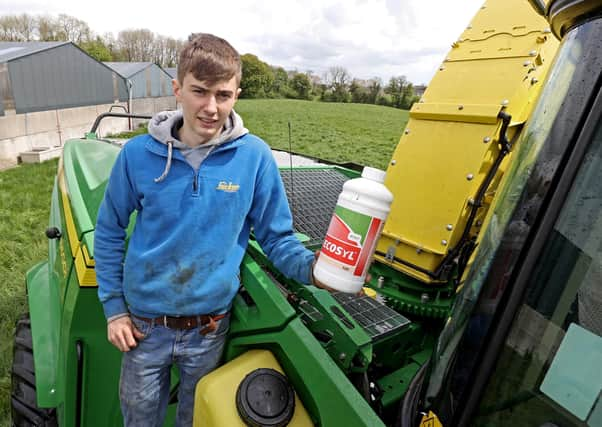The low-down on ultra-low volume additive application


As well as being suitable for applying in conventional water volumes, such as 1 or 2 litres per tonne of forage treated, certain additives can be applied in ‘ultra-low’ water volumes.
For example in 20 ml of water per tonne.
Which means up to 100 times less water needs to be fetched to the forage harvester.
How does ULV work?
Advertisement
Advertisement
As an example, a standard 2-litre bottle of Ecosyl contains enough freeze-dried beneficial bacteria to preserve 100 tonnes of forage.
With conventional application, the contents of the bottle have to be diluted with 100 litres of water if applying at a volume of 1 litre per tonne of forage, or with 200 litres of water if applying at a volume of 2 litres per tonne.
With ULV, on the other hand, the Ecosyl bottle is simply mixed with 2 litres of water (there’s a handy 2-litre mark on the bottle), then poured directly into the specially-designed ULV applicator tank. This allows an application volume of just 20 ml per tonne of forage.
In each case, the same 2-litre bottle of Ecosyl is enough to treat 100 tonnes of forage and the same quantity of beneficial bacteria is being applied per tonne. It’s just that with ULV it is being delivered onto the forage using much less water.
Advertisement
Advertisement
Whichever method is used, the bottle must first be approximately three-quarters filled with water and shaken to allow enough room for a good agitation before the final dilution is carried out.
So what are the potential benefits of ULV?
ULV application streamlines the whole harvesting operation.
1. Time savings
Carting and mixing large volumes of water for conventional application can be pretty much a full-time job with large harvesters – either for the contractor or the farmer. By making the mixing process much quicker, ULV saves time and effort.
Time saved from less water carting and waiting to fill tanks can be particularly useful if you have an out farm or conacre land.
2. Less effort
ULV is much less cumbersome than lugging about big barrels of water or lifting pumps in and out of barrels. Bottles for ULV application can be mixed virtually anywhere, and the day’s additive requirement is easily carried in the harvester or carried out to the field by a tractor returning from the clamp.
Advertisement
Advertisement
Any Ecosyl that has been mixed for ULV application is also easy to put back into its bottles if lifting is interrupted by rain or breakdowns. In its bottle diluted Ecosyl can be stored if refrigerated for up to 10 days. That compares with 1-2 days’ shelf life for a mixed barrel of the additive stored at ambient temperature.
3. Potential financial gains
Less stoppage time refilling the additive tank also means more hectares harvested per day – which increases the chance of ensiling the crop in decent weather and in optimum condition. For example not over-wilted. Switching from mixing large quantities of water to more productive tasks such as rolling the clamp better with an extra tractor helps make better silage by reducing waste.
Likewise the ease of mixing an extra additive batch with ULV cuts the temptation to leave those last few loads on top of the clamp untreated if the tank is running dry near the end of another long day. This is important because the top of the clamp is most vulnerable to heating and spoilage.
Ultimately, having a simpler and less hectic harvest workload could also lead to less stress and reduce the chance of costly mistakes.
Setting up for ULV
Advertisement
Advertisement
This technology has been in use for around 20 years. Although all self-propelled forage harvesters should be suitable for ULV application, certain types of harvesters – such as forage wagons - are not. Other than that, you simply need to install the ULV applicator, and choose the appropriate additive.
Be aware that not every additive can be applied via ULV. If it doesn’t say suitable for ULV on the label, it may not be. It is vital to check.
Ecosyl products suitable for ULV application are Ecosyl 100 for clamped grass and legumes, and Ecocool for forages at risk of aerobic spoilage (heating), such as maize, wholecrop cereals and higher dry matter grass silage.
Why aren’t all additives suitable for ULV application?
Because ULV application is in millilitres of water per tonne rather than litres, it is crucial that the additive still works as it’s supposed to at these low volumes. Beneficial bacteria in the additive must remain viable in such a small quantity of water. They must also remain in suspension without settling out. Otherwise they will settle to the bottom and be applied too heavily at the start with possibly only cloudy water applied at the end.
Advertisement
Advertisement
Similarly, the product must maintain an even application of the forage in the machine and produce the same level of fermentation in the clamp. You can’t assume all additives have been formulated to these standards.
In the case of MTD/1 bacteria in Ecosyl there has been a huge amount of research to check these areas.
Trials have shown no difference whether applied using ULV or conventionally. ULV maintained accurate, even application of the required number of beneficial bacteria per gram of forage, and there was no difference in the fermentation.
Both application methods producing significantly better silage than the untreated with higher ME and true protein with reduced dry matter losses.
For free advice contact Volac NI forage specialist Ken Stroud tel; 077 1319 7084 or Volac Ecosyl distributors in Ulster, John Thompson & Son Ltd tel; (028) 9035 1321.